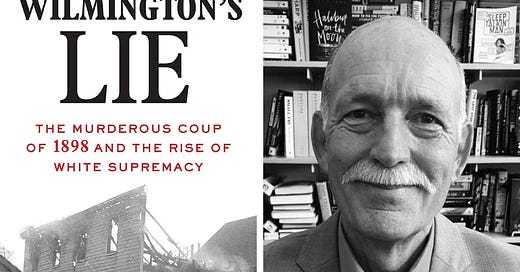Would you be kind enough to consider becoming a “Black Books, Black Minds” member supporter?
At $6.00/month or $60.00 year, your funds will help me continue to build this labor of love and deliver great Black History content to you.
Click above to update. Every little bit counts
Thank you!
Diamond-Michael Scott
By Guest Contributor Marc Friedman
In “Wilmington’s Lie: The Murderous Coup of 1898 and the Rise of White Supremacy,” author David Zucchino delivers a powerful and frightening exposé of one of the darkest chapters in post-Reconstruction history. Winner of the 2021 Pulitzer prize, it explores the 1898 massacre of Black Americans in Wilmington, North Carolina. This led to the banishment of all but a handful of Black citizens who were allowed to remain because wealthy Whites needed their services as maids, butlers and factory workers.
In the 1890’s Wilmington had become a mecca for upwardly mobile Black people. It was regarded as a model mixed-race community. There were Black businessmen, lawyers, doctors and other successful Black people. Many of the important public offices were occupied by Black citizens. There were many Black police officers in the local police department.
White supremacists found this to be intolerable believing that their White culture and traditions were slipping away. Led by a handful of white supremacist leaders along with their newspapers, large numbers of White citizens from all walks of life organized. They decided to eliminate Black people from all positions of power in order to regain all local and statewide political offices. This included replacing Black police officers in Wilmington with White Supremacists.
To accomplish their goals, the White leaders concocted a scheme known as the “Big Lie” that gave rise to the book’s title. They successfully persuaded the White population that politically corrupt Blacks were dominating their lives which was untrue. The White leaders also spread the lie that Blacks were stockpiling weapons that they intended to use for an armed insurrection.
With a stunning degree of research, the author describes how the White supremacists including judges, government officials, law enforcement and others launched a frightening armed attack on the Black community on Election Day in 1898, resulting in the murder of at least 60 Black citizens. Many others were driven from their homes into the surrounding woods and swamps where several, including children, perished. Still others were told they would be killed if they did not immediately leave Wilmington, which they did.
The campaign to destroy Wilmington’s Black community succeeded. The mob violence allowed White Supremacists to gain control of all political offices. They then passed the worst possible Jim Crow laws to ensure that Wilmington and the surrounding areas would forever remain under White control. As the author wrote, “[t]hey had turned a black-majority city into a white citadel.”
In fact, the Wilmington White supremacists were so successful that their killings and passage of Jim Crow laws inspired White supremacists throughout the South. Their campaign showed that Whites could whittle down the Black vote and Black officeholders first by violence and then with legislation. This became a model for other racist Southern States.
The story of Wilmington is relevant today. Zucchino’s gripping storytelling and profound insights are not just a recounting of historical events. Rather, they are a searing commentary on the enduring struggle for justice and equality in America.
I found that the book forces the reader to confront uncomfortable truths about America’s past and to consider the persistent legacy of systemic racism. It shows how the “Big Lie” created by the White supremacists – that Black citizens were dominating the White community and stockpiling arms for an attack upon them – fueled the rage that resulted in the unspeakable racial massacre that Zucchino describes in compelling detail.
We have seen a similar narrative replayed many times throughout history such as in the 1994 Rwandan Genocide where, many believe, a lie regarding the death of a Hutu leader sparked the killing of almost one million Tutsi’s.
In conclusion, “Wilmington’s Lie” is an important contribution not only to Black history but to American history more generally. While many know about the 1921 Tulsa race massacre, the 1898 Wilmington massacre is not as well known. But as Zucchino explains in the epilogue, the deep scars left by Wilmington sadly still exist today.







Shameful and horrific. Growing up, I learned more about the Tulsa Massacre than the earlier Wilmington Coup and Massacre, which from what you report above is not unusual. But when we moved to North Carolina 10 years ago, I learned more about the history in Wilmington, and it was absolutely mind-blowing to me. Frankly, it still is. Not only the chilling events themselves but the coverup afterward was stunning to me. They not only destroyed families but the prior records, apparently acting as though nothing unusual had taken place.
Adding this to my to read list.